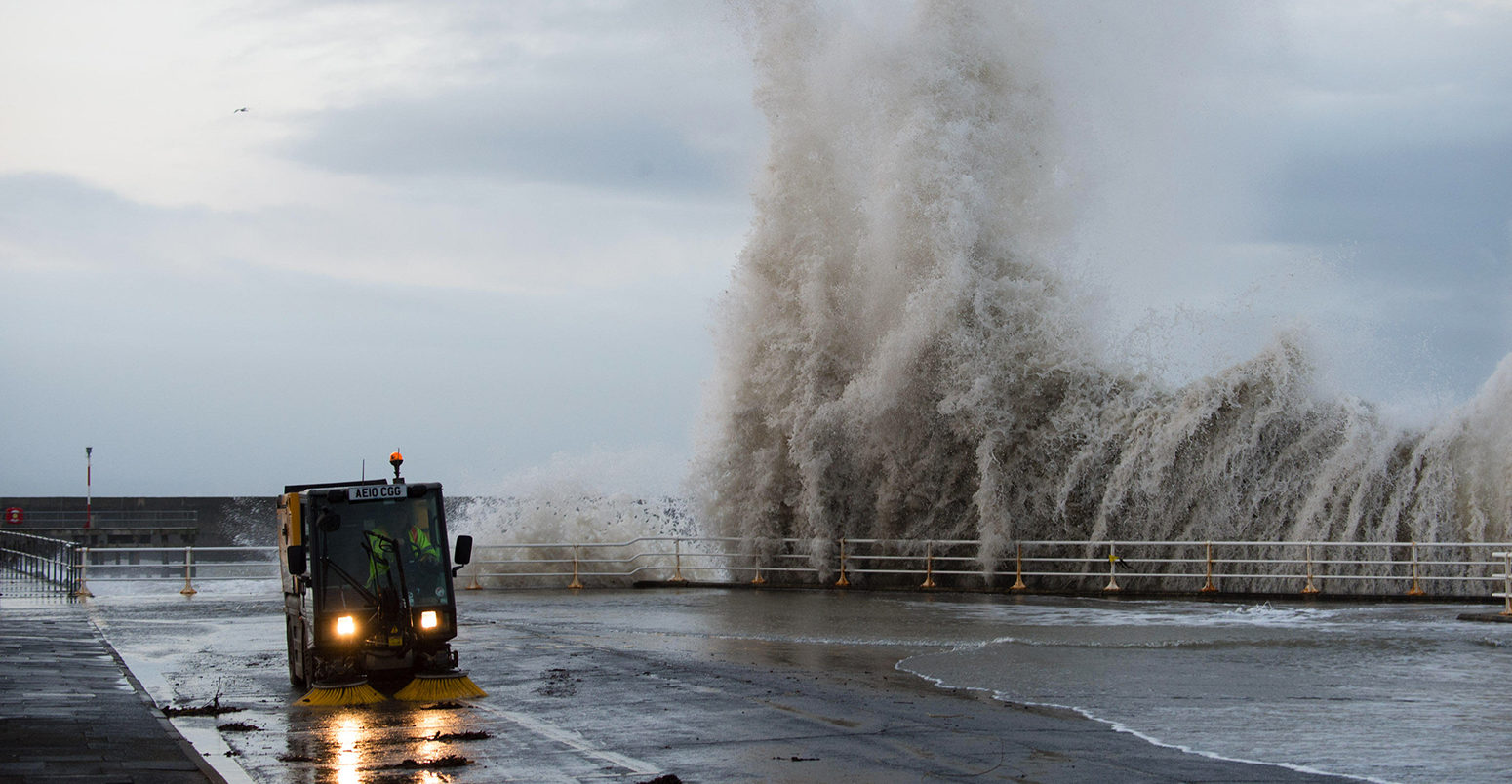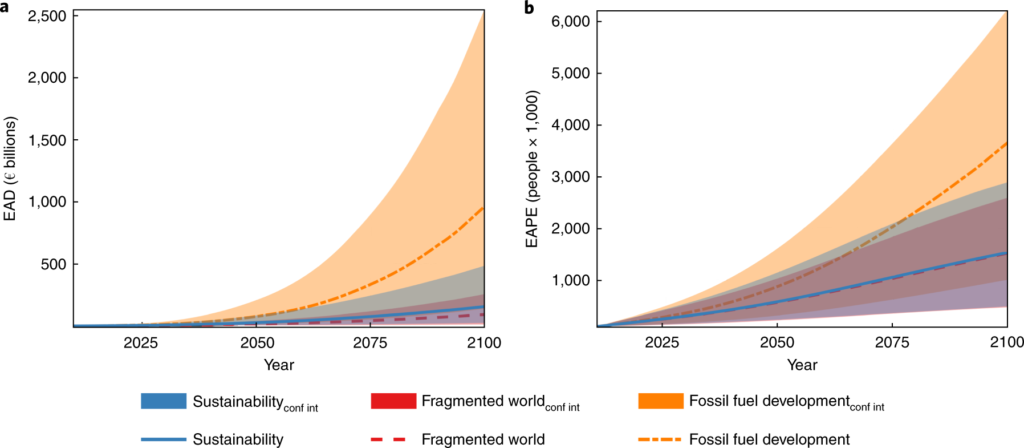
Coastal flooding in Europe ‘could cost up to €1 trillion per year’ by 2100
Jocelyn Timperley
08.13.18Jocelyn Timperley
13.08.2018 | 4:00pmThe economic damage from coastal flooding in Europe could reach almost €1 trillion per year by 2100 without new investment in adaptation to climate change, a new study finds.
The research looks at how rising sea levels and continued socioeconomic development will affect future coastal flood risk in 24 European countries.
In contrast to the past century, the main reason behind rising loses from coastal flooding will be global warming, rather than socioeconomic changes, the lead author tells Carbon Brief. The acceleration of loss is also unprecedented, he adds.
The UK would be the worst hit by far, the study finds, seeing up to €236bn in annual damages and 1.1 million people exposed to coastal flooding by 2100, if no upgrades are made to coastal protection.
Coastal damage
Europe’s coastline stretches to more than 100,000km. Many of its coastal zones are highly populated and developed.
This leaves it vulnerable to increased coastal flooding due to extreme sea levels. These arise from a combination of sea level rise, tides, and storm surges and waves due to cyclones.
Future damages due to coastal flooding will also be highly dependent on socioeconomic changes, which will impact the number of people moving to the coast and the extent of development.
The new study, published in Nature Climate Change, aims to combine modelling of both extreme sea levels and socioeconomic development to show what damages could look like this century without further adaptation efforts.
It projects that the economic damages from these extreme events will increase from €1.25bn per year today to between €93bn and €961bn per year by 2100 (in today’s money), depending on how socioeconomic trends play out over the rest of this century. This is a 75- to 770-fold increase on today’s levels.
Three socioeconomic scenarios are considered, as set out below. (Carbon Brief recently published an explainer about these new scenarios, which are known as “Shared Socioeconomic Pathways” or SSPs.)
- “Sustainability” (SSP1), where the world shifts gradually towards sustainability, with emphasis on more inclusive development that respects environmental boundaries. This is combined with a future emissions scenario known as RCP4.5, whereby greenhouse gas emissions level off by 2050 and global temperatures rise by 2-3C above pre-industrial levels by 2100. Expected annual damages from coastal flooding hit €156bn by 2100, the study finds.
- “Fragmented world” (SSP3), where countries focus on achieving energy and food security goals within their own regions at the expense of broader-based development. This is combined with RCP8.5, a high emission and low climate policy scenario where global temperatures reach around 4-6C above pre-industrial levels by 2100. Expected annual damages from coastal flooding reach €93bn by 2100, the study finds.
- “Fossil fuel-based development” (SSP5), where a push for economic and social development is seen alongside the exploitation of abundant fossil fuel resources. This is again combined with the RCP8.5 high emissions scenario. Expected annual damages from coastal flooding reach €961bn by 2100, the study finds.
The graph below shows how these annual damages for the different scenarios pan out across different European countries by 2100.
Expected median annual damage from coastal flooding for 24 European countries by 2100. The scenarios included are: RCP4.5-SSP1 (“Sustainability”), RCP8.5-SSP3 (“Fragmented world”), and RCP8.5-SSP5 (“Fossil fuel based development”). Source: Vousdoukas et al. (2018). Chart by Carbon Brief using Highcharts.It is worth noting that while emissions are considered same in this study for the “fragmented world” and “fossil-based development” scenarios, lower development and urbanisation for the former leads to less economic exposure to extreme sea levels.
In all scenarios, the UK is the worst hit in absolute economic terms, followed by France and Norway. The UK – which today accounts for around a third of damages from coastal flooding – accounts for 22-28% of damages in Europe by 2100.
Dr Michalis Vousdoukas, an oceanographer at the European Joint Research Centre in Ispra, Italy, and lead author of the paper, tells Carbon Brief the high expected damages in the UK are due to its exposure to the oceanic waves of the North Atlantic. This is one of the areas in Europe most exposed to strong ocean conditions, he says, leading to more intense weather conditions than in Mediterranean countries, for example.
Dr Andra Garner, a postdoctoral fellow in sea-level research at Rutgers University in New Jersey, who was not involved with the research, says the results of the paper are “very telling”, although emphasises that any modelling study comes with caveats. She tells Carbon Brief:
“The results here indicate that, although socioeconomic choices can be important, rising sea levels ultimately dominate future flood risk in many regions, suggesting the need for swift action towards increasing adaptation measures and resilience planning in coastal communities.”
This is especially important, adds Garner, since the ocean responds slowly to a warming climate, which means that sea level rise impacts are likely to become even more severe beyond the end of the century.
Nearer-term damage
The authors also looked at damages from coastal flooding in the shorter term. By mid-century, the study shows these would reach €21bn, €13bn and €39bn for, respectively, the “sustainability”, “fragmented world” and “fossil fuel-based development” scenarios. This is a 10- to 32-fold increase compared to the annual damage in 2000.
The breakdown of these costs among different countries by 2050 is shown in the chart below. In all scenarios, the UK is again the most affected in absolute terms, followed by France and Italy.
Expected median annual damage from coastal flooding for 24 European countries by 2050. The scenarios included are: RCP4.5-SSP1 (“Sustainability”), RCP8.5-SSP3 (“Fragmented world”), and RCP8.5-SSP5 (“Fossil fuel based development”). Source: Vousdoukas et al. (2018). Chart by Carbon Brief using Highcharts.According to the study, flood defences will need to be installed or reinforced to withstand increases in extreme sea levels of around 0.5m by 2050, and 1-2.5m by 2100, depending on the country.
GDP ratio
The researchers also calculate the expected annual damages from European coastal flooding as a share of combined total gross domestic product (GDP).
Depending on the scenario, they find that coastal flooding damages will account for 0.06-0.09% of Europe’s GDP by 2050. This rises to 0.29-0.86% of GDP by 2100. This is up from current average damage from coastal flooding in Europe today of around 0.01% of GDP.
Some countries are particularly hard hit, when viewed in this way. The study finds Norway would see damages equal to between 1.7-5.9% of its GDP, depending on the scenario, by 2100. Damages in Cyprus would equal 1.7-8.3% of its GDP and in Ireland it would be 1.8-4.9% of GDP.
A key point here is that river flooding in Europe is currently much more damaging than coastal flooding in GDP terms, the study says, with an average €6bn in annual damages, equivalent to around 0.04% of GDP. This will change, according to the study, with flood risk increasingly dominated by coastal flood risk from 2050 onwards, unless flood-protection standards are upgraded. Vousdoukas tells Carbon Brief:
“In the future, the coastal flooding becomes four times more important than river flooding, because of the accelerating factor which is sea level rise basically. Coastal flooding will change so much, there will be so higher damages, that it will become more important. Then there needs to be spending there for protection.”
People affected
As well as looking at economic damages, the new study projects the number of people who will be affected by coastal flooding. This depends not only on the extent of increase in extreme events, but also how many are living in coastal zones. Therefore, as for economic damages, socioeconomic development will have a large impact alongside climate change.
The study finds the annual number of people in Europe exposed to flooding will rise from 102,000 today to between 530,000 and 740,000 by 2050 (again, in the absence of further adaptation measures). By 2100, 1.5 million Europeans would be affected by coastal flooding in the “fragmented world” scenario, the study finds, and 3.7 million in the “fossil fuel-based development” scenario.
The three graphs below show the projected number of people affected in each country for the three scenarios in 2100. Again, the UK is by far the most impacted across all three scenarios.
Expected median number of people affected by coastal flooding per year in 24 European countries in 2100. The scenarios included are: RCP4.5-SSP1 (“Sustainability”), RCP8.5-SSP3 (“Fragmented world”), and RCP8.5-SSP5 (“Fossil fuel-based development”). Source: Vousdoukas et al. (2018). Chart by Carbon Brief using Highcharts.High uncertainty
It is important to remember that the projections in the study come with a very high uncertainty, Vousdoukas stresses.
The chart below shows the projected change of coastal flood impacts up to 2100 for the three scenarios. The dotted line show the median projections, as described above, while the coloured areas show the large potential range in the results.

Evolution of coastal flood impacts aggregated at European level for 24 countries under three socioeconomic scenarios: (a) shows the projected changes in expected annual damages and (b) the expected annual number of people exposed due to coastal flooding. The lines are the ensemble median projections and the coloured areas show the 5-95% quantile range confidence interval. Source: Vousdoukas et al. (2018)
Commenting on the paper, Dr Diego Rybski, deputy head of climate change and development group at the Potsdam Institute for Climate Impact Research tells Carbon Brief the paper “significantly contributes” to the understanding of coastal flood risk and sea level rise in Europe. However, he adds that such assessments of coastal flood risk are affected by further large uncertainties.
For example, he says, it is hard to know when the inundations are going to take place because coastal flood are very rare. The impact of a once-in-100-year event in the first half of the century could be very different than if it occured in the second half of the century. It is also possible that there is no such event, or more than one, during a given 100 years.
Vousdoukas, M, I. et al. (2018) Climatic and socioeconomic controls of future coastal flood risk in Europe, Nature Climate Change, . doi:10.1038/s41558-018-0260-4
-
Coastal flooding in Europe ‘could cost up to €1 trillion per year’ by 2100
-
Coastal flooding ‘could affect up to 1.1 million people’ in the UK by 2100

